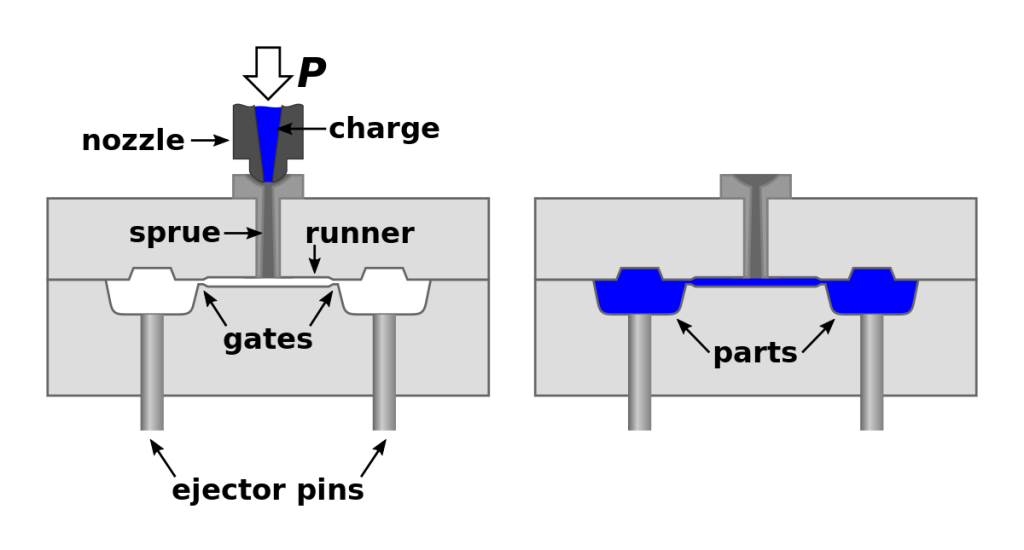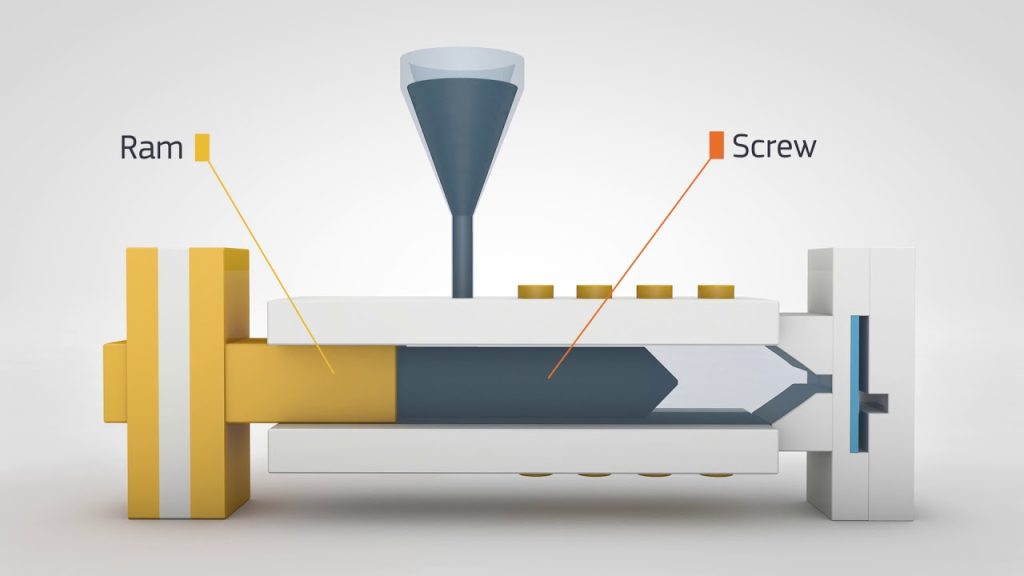Injection molding is a popular manufacturing process that has revolutionized the production of plastic products. The process involves injecting molten plastic into a mold cavity and allowing it to cool and solidify before the final product is ejected. During this process, the mold needs to be constantly cooled to maintain the desired shape and prevent deformation. This is why injection molding dies are typically water-cooled.
Water-cooled injection molding dies offer several advantages over other cooling methods. Firstly, water has a high thermal conductivity, which means it can absorb heat quickly and efficiently. This makes it an ideal cooling medium for injection molding dies as it helps to maintain a constant temperature and prevent warping. Additionally, water-cooled dies are more cost-effective and energy-efficient compared to other cooling methods, making them a popular choice among manufacturers.
Why Are Injection Molding Dies Typically Water Cooled?
Injection molding is a widely used manufacturing process for producing plastic parts. The process involves injecting molten plastic material into a mold cavity, which then solidifies and is ejected from the mold. The quality of the final product is largely dependent on the temperature control of the mold during the injection process. Water cooling is the most common method used to control the temperature of injection molding dies. In this article, we will explore why injection molding dies are typically water cooled.
Heat Generation in Injection Molding
Injection molding is a process that generates a significant amount of heat due to the friction between the molten plastic material and the walls of the mold cavity. The temperature of the mold is critical to the quality of the final product. If the mold is too hot, the plastic material may melt too quickly or deform, resulting in defects in the final product. On the other hand, if the mold is too cold, the material may not flow properly, and the final product may have surface defects.
The Role of Water Cooling in Injection Molding
Water cooling is the most common method used to control the temperature of injection molding dies. The cooling system typically consists of water channels that are incorporated into the mold design. The water flows through these channels, absorbing heat from the mold, and then dissipating it through a heat exchanger. The cooled water is then circulated back through the mold to maintain a consistent temperature.
Benefits of Water Cooling
Water cooling offers several benefits over other cooling methods. Firstly, water has a high heat capacity, which means that it can absorb a lot of heat before its temperature increases significantly. This makes it an effective cooling medium for injection molding dies, which generate a lot of heat during the process. Secondly, water cooling is a cost-effective method, as it does not require any additional equipment or power sources. Finally, water cooling is a reliable and consistent method, providing precise temperature control over long periods.
Water Cooling vs. Air Cooling
Air cooling is an alternative method to water cooling, where air is used to cool the mold. While air cooling is a simpler method compared to water cooling, it has several drawbacks. Firstly, air has a low specific heat capacity, which means it cannot absorb as much heat as water. This results in longer cooling times and less precise temperature control. Secondly, air cooling can cause uneven cooling, resulting in defects in the final product.
Water Cooling vs. Oil Cooling
Oil cooling is another alternative method to water cooling, where oil is used to cool the mold. While oil cooling has a higher specific heat capacity than air, it is not as effective as water cooling. Oil cooling also requires additional equipment and maintenance, making it a more expensive method compared to water cooling. Furthermore, oil cooling can have environmental implications, as it requires the use of oil, which can be harmful to the environment if not disposed of properly.
Cooling Channel Design
The design of the cooling channels in the mold is critical to the effectiveness of the water cooling system. The channels should be designed to provide even cooling across the mold surface, to prevent defects in the final product. The spacing and diameter of the channels should be optimized to maximize cooling efficiency while minimizing the amount of water required.
Factors Affecting Cooling Efficiency
Several factors can affect the efficiency of the water cooling system. These include the flow rate of the water, the temperature of the water, the spacing and diameter of the cooling channels, and the material properties of the mold. It is essential to optimize these factors to ensure that the cooling system provides consistent and precise temperature control.
Maintenance and Cleaning
Regular maintenance and cleaning of the water cooling system are essential to ensure its effectiveness. The cooling channels should be checked regularly for blockages or corrosion, which can affect the efficiency of the system. The water quality should also be monitored, and the system should be cleaned regularly to prevent the buildup of contaminants.
In Conclusion
Water cooling is the most common method used to control the temperature of injection molding dies. It offers several benefits over other cooling methods, including cost-effectiveness, reliability, and precise temperature control. The design of the cooling channels is critical to the effectiveness of the water cooling system, and regular maintenance and cleaning are essential to ensure its longevity.
Frequently Asked Questions
Why are injection molding dies typically water cooled?
Injection molding is a process that involves heating plastic material to a molten state and injecting it into a mold cavity. The mold is typically made of metal and is designed to create a specific shape or form. During the injection molding process, the plastic material is subjected to high pressure and high temperatures. This can cause the mold to become too hot and deform or warp. To prevent this from happening, injection molding dies are typically water cooled.
Water cooling is a highly effective way to regulate the temperature of the injection molding die. The cooling system consists of channels or passages that run through the mold. Cold water is circulated through these channels, absorbing heat from the mold and keeping it at a consistent temperature. This helps to ensure that the molded parts are of high quality and that the mold itself does not become damaged or deformed.
While there are other cooling methods that can be used for injection molding, such as air or oil cooling, water cooling is the most common and effective. It allows for precise temperature control and helps to prevent defects in the finished parts. Overall, water cooling is an essential part of the injection molding process and plays a critical role in producing high-quality, consistent parts.
What are the benefits of water cooling for injection molding dies?
Water cooling offers several key benefits for injection molding dies. First and foremost, it helps to ensure that the mold remains at a consistent temperature throughout the injection molding process. This is critical for producing high-quality parts that are free from defects. Additionally, water cooling can help to increase the lifespan of the mold by preventing overheating and warping. This can save manufacturers money in the long run by reducing the need for costly repairs or replacements.
Another benefit of water cooling is that it allows for precise temperature control. By adjusting the flow rate and temperature of the cooling water, manufacturers can fine-tune the injection molding process to achieve optimal results. This can help to improve efficiency and reduce waste by minimizing the number of defective parts that are produced.
Overall, the benefits of water cooling make it an essential part of the injection molding process. It helps to ensure that the mold remains at a consistent temperature, prevents defects in the finished parts, and can save manufacturers money by prolonging the life of the mold.
In conclusion, injection molding is a widely used manufacturing process that requires the use of molds or dies. These molds are typically made of steel and can become extremely hot during the plastic injection process. This is why water cooling is commonly used to maintain the temperature of the molds and prevent damage or warping.
The use of water cooling also helps to increase the efficiency and speed of the injection molding process. By rapidly cooling the molds, they can be opened and closed more quickly, allowing for faster production cycles and higher output. Additionally, the use of water cooling can also improve the quality and consistency of the finished products.
Overall, water cooling is a critical component of the injection molding process, allowing for increased efficiency, improved quality, and longer lifespan of the molds. As the demand for plastic products continues to grow, injection molding will remain an important manufacturing method, with water cooling playing a crucial role in its success.
Request a quote today!
[contact-form-7 id="1578" title="Contact form"]
Please compress the file into a ZIP or RAR file before uploading. Alternatively, send through your RFQ by email.
enquires@unitymanufacture.com





